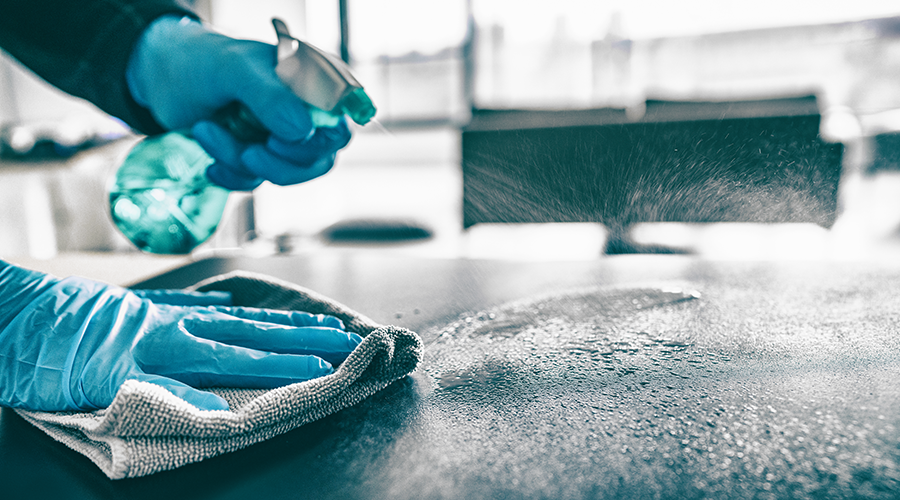Disinfecting is a crucial part of any healthcare facility’s functioning. However, there are a myriad of different cleaners/disinfectants available, with there even being a distinction between traditional and “hospital grade” ones. Understanding that difference can prove critical to effectively disinfecting. In this manufacturer roundtable, Healthcare Facilities Today speaks with disinfectant manufacturers about the difference between traditional and “hospital grade” products.
What is the difference between traditional and "hospital grade" cleaners and disinfectants and why is it important to use the proper product?
“According to the Environmental Protection Agency (EPA), “A disinfectant that is a general or broad-spectrum disinfectant and also is effective against the nosocomial bacterial pathogen Pseudomonas aeruginosa” is defined as a hospital grade disinfectant. In the continuum of efficacy claims, disinfectants go from limited, to broad spectrum to hospital grade.”
— Caryn Gilliam, chief strategy officer, PortionPac Chemical Corporation
“Hospital-grade disinfectants must be EPA-registered and at a minimum, demonstrate efficacy against two qualifying bacteria – Staphylococcus aureus (a gram-positive bacteria) and Pseudomonas aeruginosa (a gram-negative bacteria). It is important to note it is not a requirement to include the language “healthcare-grade” on the disinfectant label.
Decision-makers should review the label for claims against S. aureus and P. aeruginosa. In addition to being a regulatory requirement, it is important to use healthcare-grade disinfectants because they are designed for use in this high-consequence setting. These products are formulated with healthcare surfaces and common pathogens in mind to help improve patient safety. On any given day, one in 31 hospitalized patients have at least one healthcare-associated infection (HAI). An estimated 72,000 of these patients will die from these infections while hospitalized, so it is important to use the right products and processes.”
— Doe Kley, infection prevention fellow, Clorox Healthcare’s Clinical and Scientific Affairs Team
“This is an interesting question that deserves more of a spotlight. Traditional cleaners are usually quat-based, whereas the term "hospital grade" implies that the disinfectant has undergone rigorous testing and meets stringent standards set by organizations such as the EPA and can be used in a healthcare environment. Additionally, it should demonstrate high-log reductions in the targeted microbes. SteraMist, for example, is a hospital-grade disinfectant that aligns with these stringent criteria, offering an effective solution for healthcare environments.
Choosing an ineffective or unsuitable cleaning product for your area can have significant consequences. Beyond the potential increase in healthcare-associated infection (HAI) risk, the use of traditional cleaners may result in surface damage or contribute to greater hospital spending due to extended hospitalization times.
For environmental services (EVS) staff, ensuring the effectiveness of cleaning and disinfection practices involves several key considerations:
- Understanding the Cleaning Objective:
- Clearly define what needs to be cleaned and disinfected in each area.
- Training and Technique:
- Providing proper training on the use and selection of cleaning and disinfection materials.
- Emphasizing the importance of practicing the correct technique during cleaning procedures.
- Proper Tools and Equipment:
- Ensuring that staff have access to the appropriate tools and equipment for effective cleaning.
- Implementing a no touch technology like SteraMist as a hospital-grade disinfectant can further enhance the cleaning arsenal while it provides a reliable six-log solution for the toughest of microbial reduction.
- By addressing these aspects, EVS staff can contribute significantly to maintaining a clean and safe healthcare environment, reducing the risk of infections and promoting overall patient well-being.”
— Spokesperson from TOMI Environmental Solutions Inc.
Jeff Wardon, Jr. is the assistant editor for the facilities market.

 Hand, Foot and Mouth Disease on the Rise
Hand, Foot and Mouth Disease on the Rise Preparing for the Hazards of Winter Weather
Preparing for the Hazards of Winter Weather BayCare Reveals Pagidipati Children's Hospital at St. Joseph's
BayCare Reveals Pagidipati Children's Hospital at St. Joseph's Why Identity Governance Is Becoming a Facilities Management Issue
Why Identity Governance Is Becoming a Facilities Management Issue Habitat Health Opens South Los Angeles PACE Center
Habitat Health Opens South Los Angeles PACE Center